The Kanshudo Blog - older posts
Welcome to the Kanshudo blog! Here you can find older blog posts; the most recent ones are
here.
Posted: 2025-08-31,
Tags:
joy-o-kanji
kanji
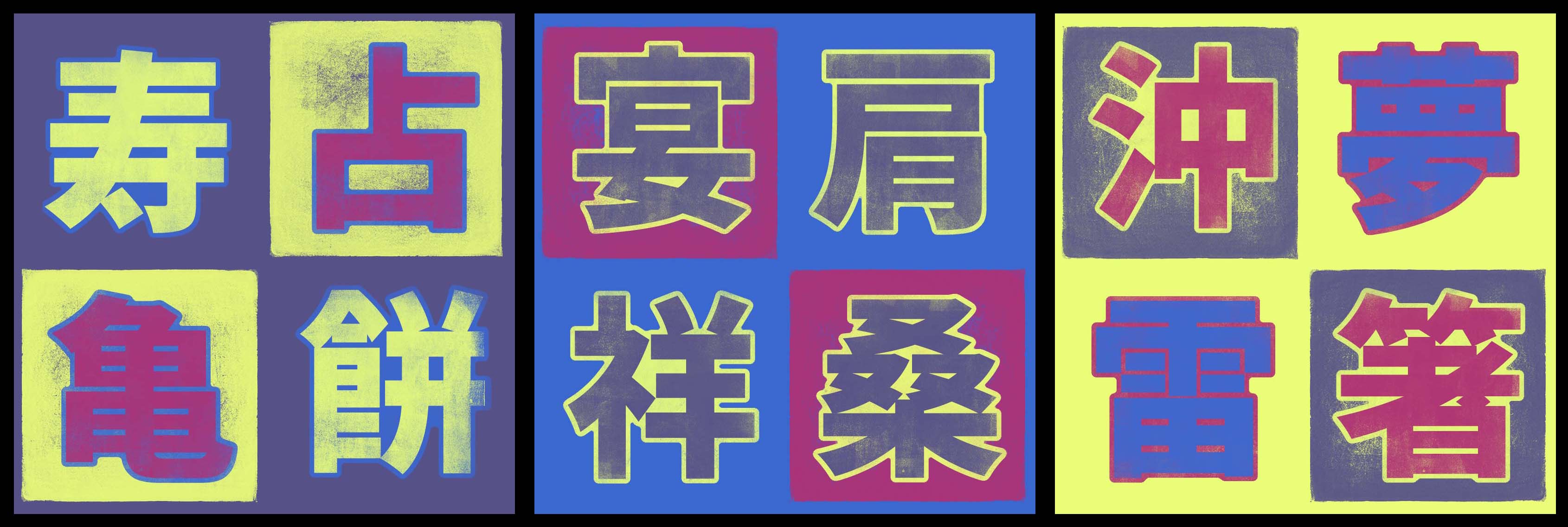
Superstition governs far more in Japan than outsiders might realize. Three new bundles show how the Japanese try to usher in luck and avoid problems. The collection also explains the beliefs driving this behavior.
65
Lots of Luck
寿 占 亀 餅

66
Staving Off Doom
宴 肩 祥 桑
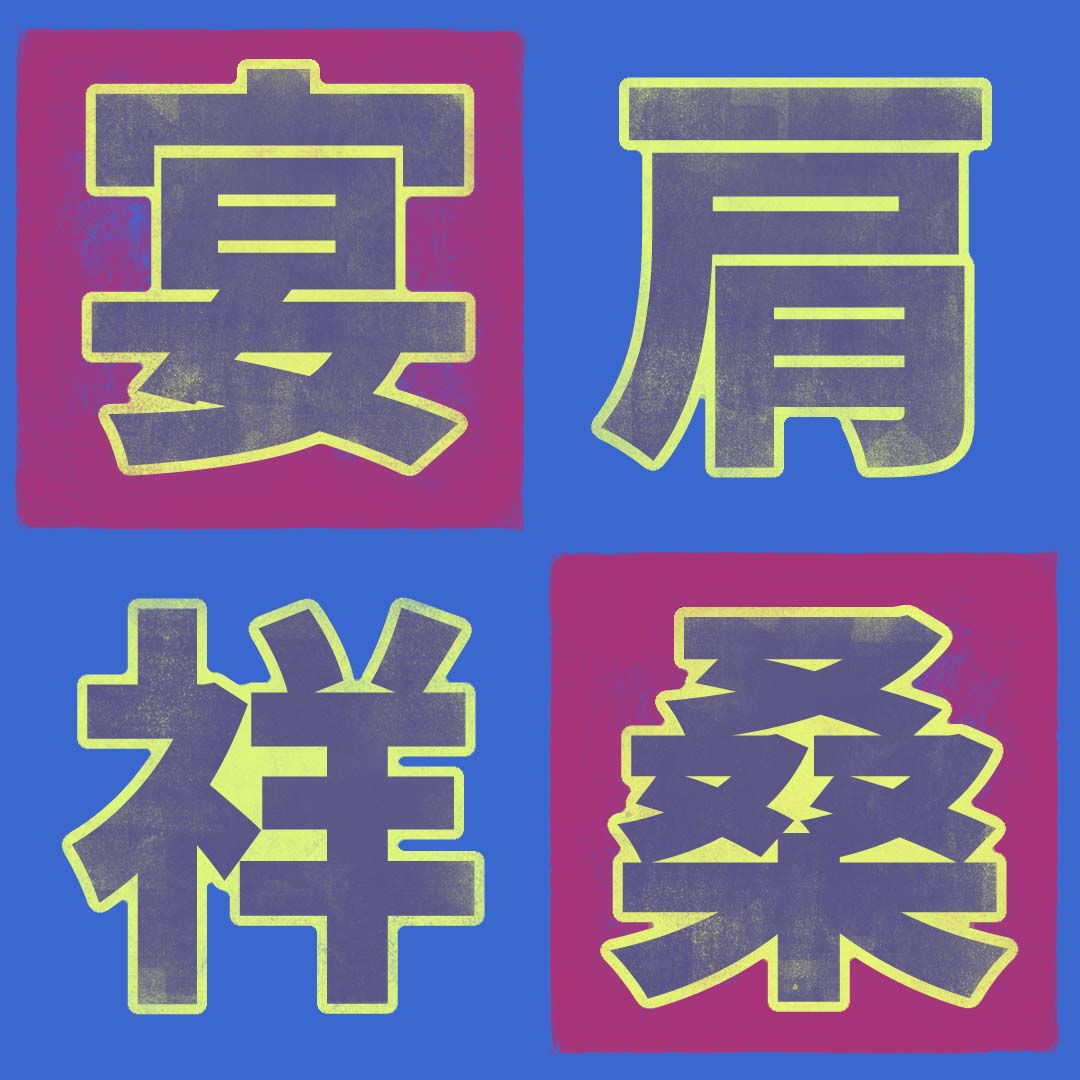
67
Of Gods and Monsters
沖 夢 雷 箸

Posted: 2025-07-31,
Tags:
joy-o-kanji
kanji
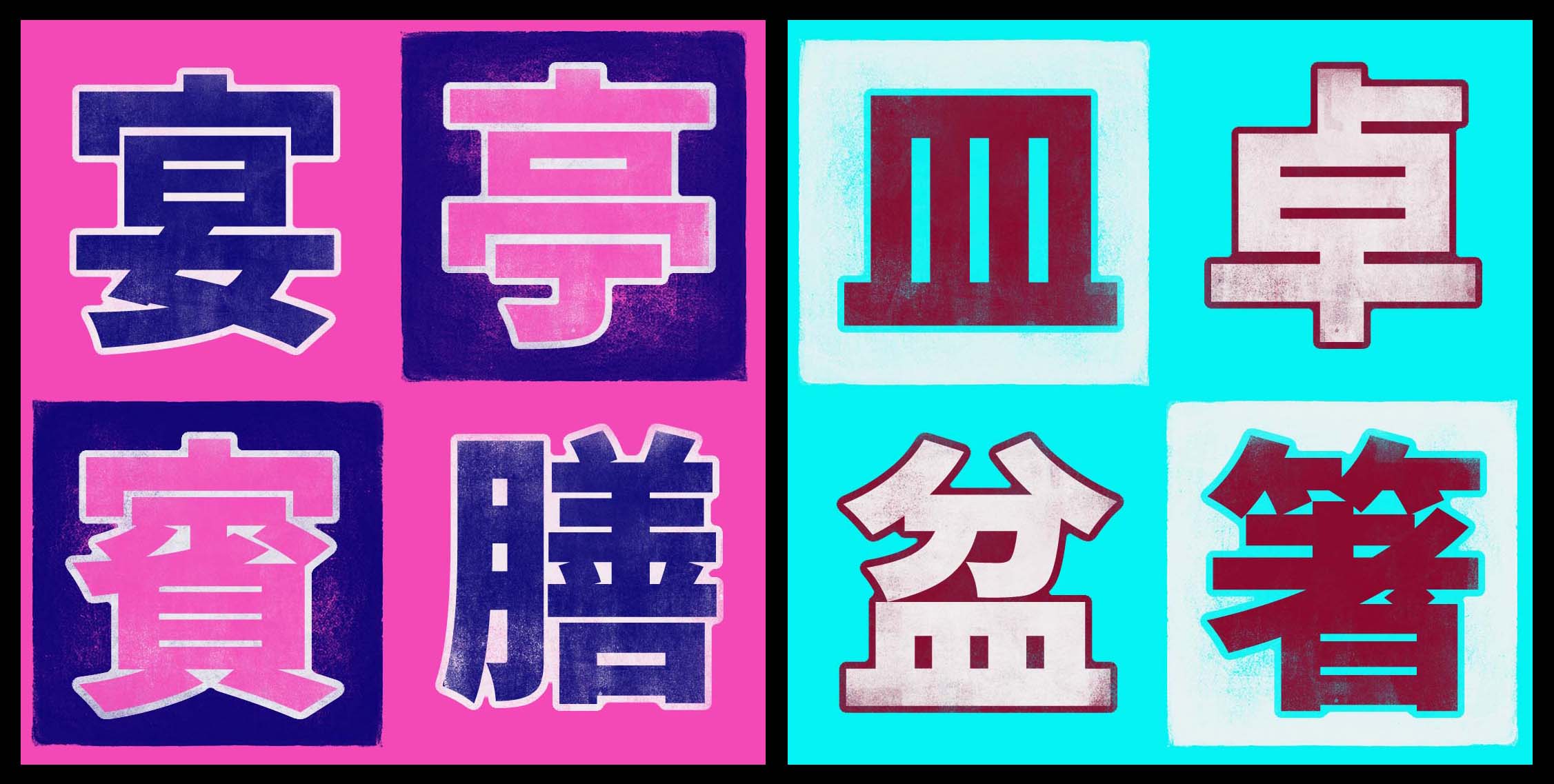
Check out our two newest kanji essay Thematic Bundles! One bundle focuses on hospitality when it comes to formal, elegant feasts and swanky lodging. The other bundle spotlights the tools used in everyday dining: dishes, trays, chopsticks, and tables.
63
Host with the Most
宴 亭 賓 膳
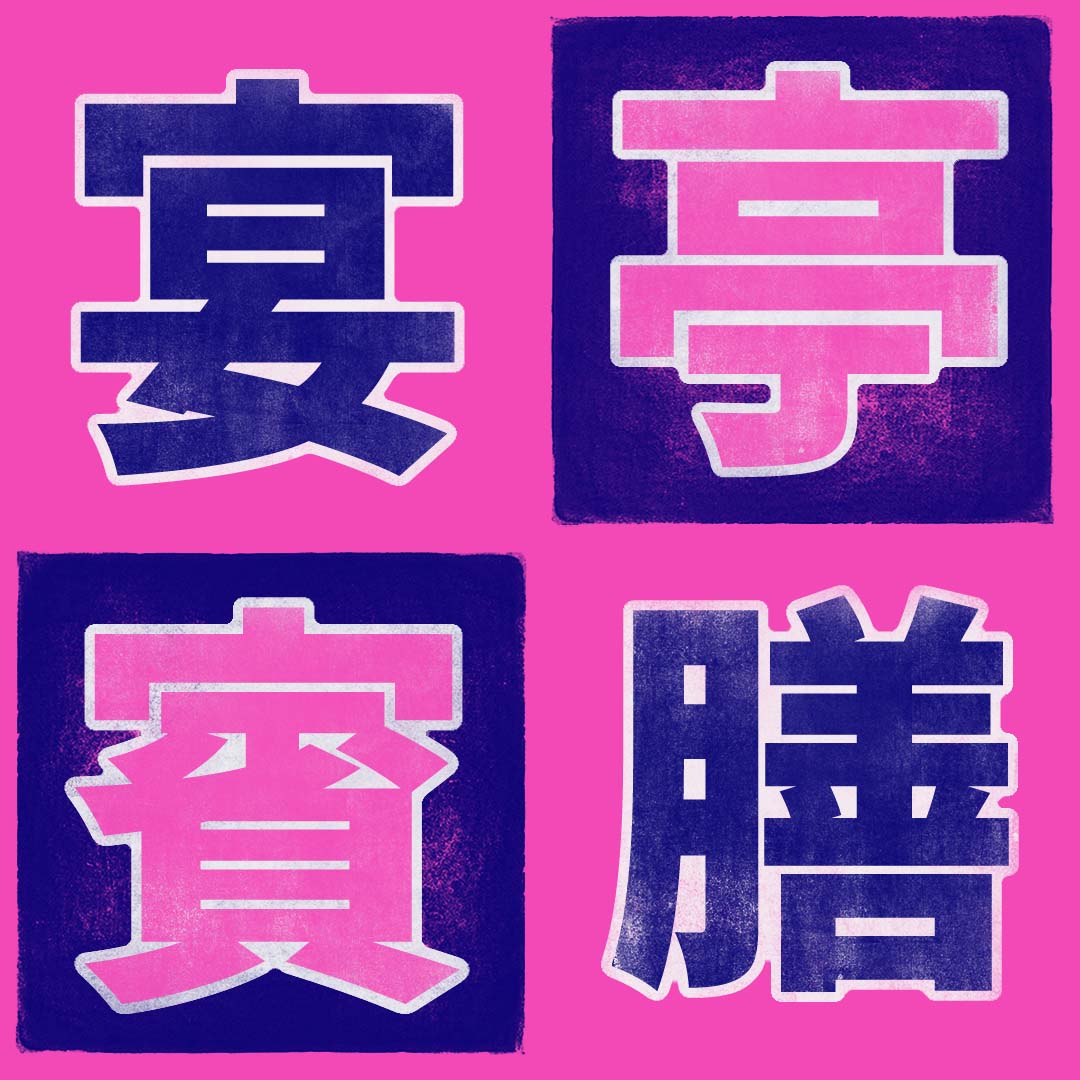
64
Tools for Daily Dining
皿 卓 盆 箸
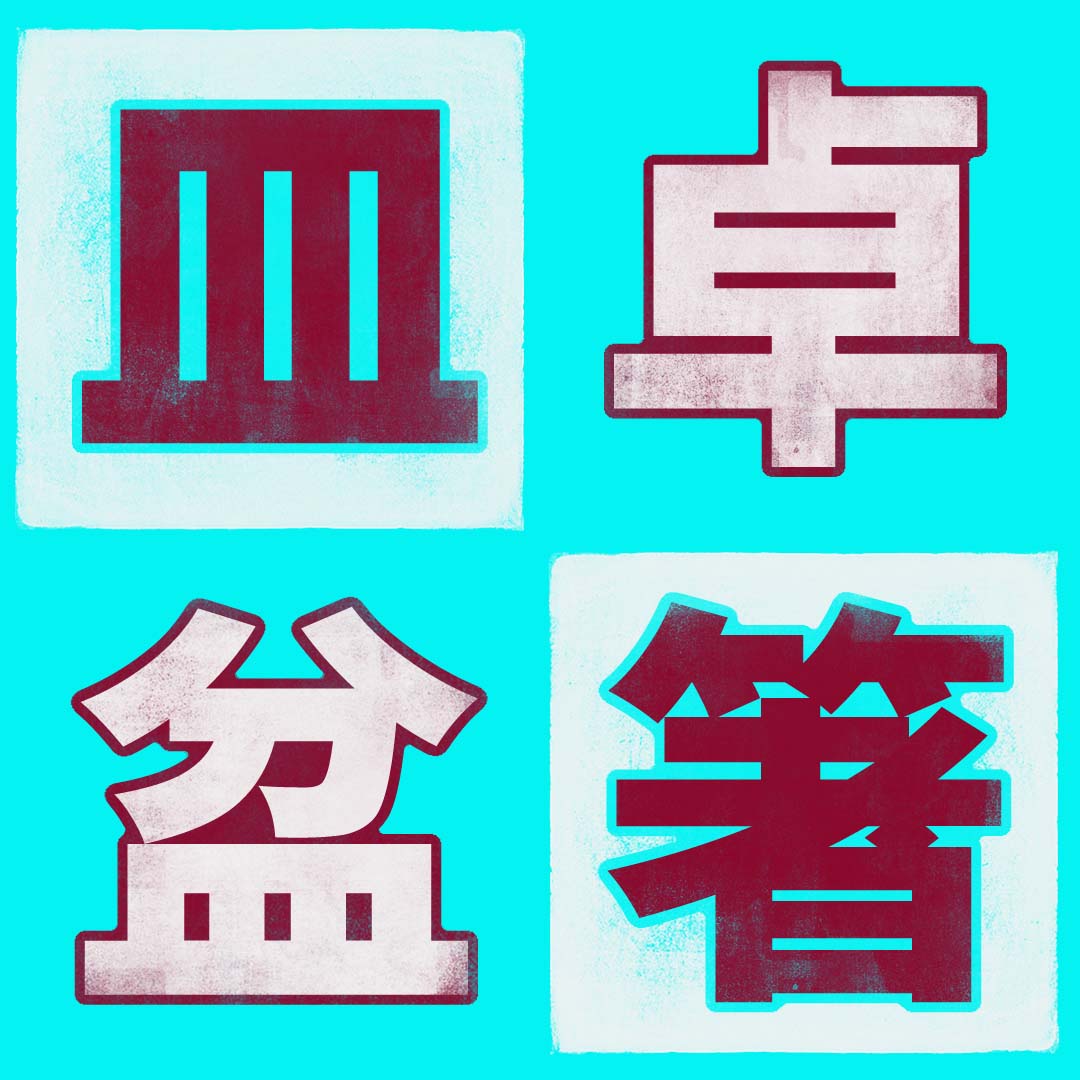
Posted: 2025-06-27,
Tags:
joy-o-kanji
kanji

One bundle helps you play house, spotlighting kanji related to household furnishings. The other bundle introduces four characters with which you can pour yourself into a pursuit, for better and for worse!
61
Home Furnishings
床 卓 棚 椅

62
Hopelessly Devoted
凝 傾 酔 陶

Posted: 2025-05-31,
Tags:
joy-o-kanji
kanji

Two new bundles show how the Japanese speak of clothing parts (collars, sleeves, and hems) and accessories (hats, umbrellas, fans, and shoes) in both literal and figurative ways.
59
Accessories as Metaphors
靴 傘 扇 履

60
Fashion Can Be Figurative
襟 帽 袖 裾

Posted: 2025-04-30,
Tags:
joy-o-kanji
kanji

Two new bundles spotlight the places where land meets sea in Japan, creating distinctive shapes, sometimes causing shipwrecks, and inspiring place names and designs.
57
The Shape of Water
潟 江 礁 湾

58
A Complex Coastline
崎 浜 浦 岬


Pop kanji that fit the descriptions! Build your kanji knowledge with our latest fun kanji game.
We're very excited to announce that we've now launched our first standalone game in quite some time: Kanji Pop. In each round, you're presented with a grid of 16 kanji. You'll be given a series of descriptions, each of which will match one or more of the remaining kanji. Select the correct kanji to 'pop' it and clear it from the grid. Try to complete as many rounds as you can!
All your answers are recorded below the game board for each round, so you can easily Favorite any you want to come back to later.
In the settings area, you can choose the kanji you want to focus on - by default, the game will focus on kanji with your current usefulness / JLPT level.
You can access Kanji Pop from the PLAY menu at the top of every page, or from the links at the bottom of every page. As with all Kanshudo features, you can also just use Quick Search.
When you've played a few games, please let us know what you think!
For more Japanese kanji, word and grammar games to help make your Japanese studies fun, see all our games in the Play Index.
Posted: 2025-03-31,
Tags:
joy-o-kanji
kanji

Two new Thematic Bundles focus on the itty-bitty - but in opposite ways. With the kanji in Bundle 55, the Japanese grouse about having too little, whereas an affection for all that is small and cute streams through Bundle 56.
55
Size of a Postage Stamp
蚊 狭 猫 涙

56
Adorably Petite
掌 豆 姫 零

Posted: 2025-02-26,
Tags:
joy-o-kanji
kanji
These two bundles belong together, the eight essays collectively constituting a celebration of the fabulous fabrics of Japan. We all know about brightly colored kimonos for formal occasions, but these bundles shine the spotlight on less-famous casual kimonos and show how craftspeople create stunning effects, colors, and patterns with these fabrics.
53
Casual Kimonos
紺 丈 雰 桁

54
Fabulous Fabrics
絞 麻 巾 藍

Posted: 2025-01-28,
Tags:
joy-o-kanji
kanji

It feels auspicious when a new year dawns. At such times, symbolism matters greatly, particularly to the Japanese. Appropriately, Bundle 51 presents kanji associated with longevity, milestone birthdays, and New Year's Day itself. January also brings resolutions to whip ourselves into shape, whether physically, mentally, spiritually, or emotionally, so Bundle 52 on training and discipline is quite relevant, as well.
51
Long-Lived
寿 松 亀 鶴

52
Relentless Improvement
鍛 鋳 錬 冶


It's our favorite time of the year here at Kanshudo, and we're delighted to help you celebrate with a fantastic bargain: 50% off one year of Kanshudo Pro* access!
Take advantage of this very special holiday offer now: Give me 50% off!
2024 has been another busy year for Kanshudo. Our biggest ever new feature, a comprehensive JLPT Practice Center, complete with timed sample tests, detailed result breakdowns, and the ability to practice question types independently, is now in beta, and we're working hard on adding the remaining features and more content. (For more information or to apply, see the blog post.) The JLPT includes about 15 different exercise types per N level, and around 50 across all N levels, so we've added many new exercises and variations which we will gradually roll out into other parts of Kanshudo.
In addition, we've added lots of new content, including 20 brand-new Topic Lessons, 42 Joy o' Kanji essays, 32 additional articles in the Grammar Library, 6 Points of Interest, not to mention nearly 2000 new example sentences. We've also added 38 Joy o' Kanji Thematic Bundles, collections of four related kanji that will really help you cement your understanding and deepen your knowledge of each set.
Take advantage of this very special holiday offer now: Give me 50% off!
Set yourself up for Japanese success in 2025. Kanshudo is the leader in personalized Japanese learning, and the most effective way to learn Japanese:
- Kanshudo's AI tutor - custom learning programs for everyone, from beginners to experts
- Detailed study guides including our very popular Definitive guide to Japanese pitch accents
- Automatic spaced repetition flashcards - quickly and easily create flashcards for kanji, words, grammar, and example sentences
- Graded lessons (Beginner Lessons and Intermediate Lessons) as well as Topic Lessons (each focused on a specific topic)
- Comprehensive kanji, word, name, and Japanese grammar dictionaries (accessible all together in Quick Search)
- Optional access to over 500 in-depth kanji essays from our partner Joy o' Kanji
Kanshudo will help you master kanji, hiragana, and katakana, along with Japanese grammar and vocabulary, as fast, effectively, and enjoyably as possible! Kanshudo is used by over 210,000 Japanese learners, with proven results. Act now and get Pro access for less than 25 cents per day!
Take advantage of this very special holiday offer now: Give me 50% off!
- Valid for any annual plan (Kanshudo, Kanshudo + Joy o' Kanji, Kanshudo + AI) for users without a current Pro plan
To view a video introduction to Kanshudo and our holiday sale, click here!
Posted: 2024-11-27,
Tags:
joy-o-kanji
kanji

As these bundles show, we cannot always be strong and dominant. One collection spotlights the inevitable process of weakening and dying, showing how to discuss this in terms of individuals, vegetation, and whole countries. The other collection features the ultra-important topic of using humble language in Japanese and how doing so completely alters one's speech.
47
Vicissitudes
朽 枯 衰 萎

48
Humble Pie
謙 拙 弊 遜

Posted: 2024-10-30,
Tags:
joy-o-kanji
kanji

Trees soar to great heights in two new bundles. One focuses on what the cherry, pine, cedar, and willow symbolize to the Japanese. The other collection shows how Japanese craftspeople make the best use of cedar, mulberry, willow, and persimmon.
45
Emblematic Trees
桜 松 杉 柳

46
Working with Wood
杉 桑 柳 柿

Posted: 2024-09-30,
Tags:
joy-o-kanji
kanji

Two new bundles put the spotlight on animals. One focuses on what the dragon, tiger, crane, and turtle symbolize in both positive and negative ways. The other collection shows how Japanese view the cats, monkeys, deer, and bears that surround them, whether at home, in city parks, or on trails through the wilderness.
43
Strongly Symbolic Animals
竜 亀 虎 鶴

44
Omnipresent Animals
猿 猫 熊 鹿

Posted: 2024-08-31,
Tags:
joy-o-kanji
kanji

From pride to shame, two bundles illuminate powerful emotions. The insect bundle (which includes essays about the mosquito and bee) dovetails naturally with the collection on skin. And all four bundles differentiate kanji or words with similar meanings.
39
Bugging Out
蚊 蛍 昆 蜂

40
Skin Deep
潤 燥 肌 膚

41
Pride: Positive or Poisonous
誇 慢 玩 傲

42
Dying of Embarrassment
肩 恥 羞 膝

Posted: 2024-08-02,
Tags:
jlpt

We're very excited to announce the beta of a major new section of Kanshudo: the JLPT Practice Center. The new center will enable you to take full length timed practice tests using the same question types and scoring as the live JLPT. It will help you to identify any weaknesses, and address them.
The JLPT, or Japanese Language Proficiency Test, now about 40 years old, is the most widely adopted certification of Japanese language proficiency for non-native speakers, and is taken by about a million students every year. Our new system covers all parts of the JLPT, including kanji / vocabulary, grammar, reading and listening.
We're launching the beta with the first N5 practice test in place - over the next few weeks, we'll be adding more N levels, more practice tests for each level, and features to enable you to practice specific question types.
To sign up for the JLPT beta, please click here.
As a side note, thank you to all of you who have expressed interest in joining the betas for several other features we have in development. All of those features are still coming, but we wanted to get this JLPT feature (along with another key new AI-related feature we're working on) launched first.
Posted: 2024-07-31,
Tags:
joy-o-kanji
kanji

The four newest bundles provide a crash course in the Japanese arts. One focuses on manga, another on calligraphy, and a third on the artistic mindset, as well as genres from painting to woodworking to tattoos. As for the fourth bundle, it's all about fear. That might seem unrelated, but being an artist means overcoming fear of failure and forging into a mental space where creativity brings on fearlessness.
35
Fear Factor
虞 恐 怖 惧

36
The Meanings of Manga
娯 撤 漫 勃

37
Inkblots
朱 跡 墨 痕

38
The Artistic Mindset
彩 匠 彫 緻

Posted: 2024-07-01,
Tags:
joy-o-kanji
kanji

One of the best things about learning kanji is seeing how the Japanese take symbols for objects (from eyebrows to bubbles in this selection) and spin off rich idioms. We find plenty of that in these four bundles, as well as fanciful beliefs about how weather works. A fourth bundle presents intriguing connections between smells and behavior, as well as fascinating relationships among the kanji in that bundle.
31
Scents and Sensibility
香 臭 嗅 匂

32
Reading the Face
唇 顎 眉 頬

33
The Inevitable Storm
嵐 稲 梅 雷

34
A Taste of Transience
浮 泡 夢 露

Posted: 2024-06-28,
Tags:
ai
We are delighted to announce that we are increasing the number of AI credits included in all 2024 pricing plans! Prices are staying the same - you just get more value from Kanshudo!
Kanshudo monthly and annual subscriptions (with or without Joy o' Kanji essays) will now include 50 credits per month. AI monthly and annual subscriptions will now include 500 credits per month. The additional credits will be applied to your subscription automatically at the beginning of the month (if you are on an annual plan) or when your next payment is made (if you're on a monthly plan).
AI credits can be used for AI Sentence Correct - type or speak a Japanese sentence, and Kanshudo will correct any mistakes, supply alternatives with a similar meaning, and provide other commentary. Sentence Correct is a fantastic way to develop confidence in your Japanese, as well as to ensure important communications are error free. For more information read the blog post.
Additionally, AI credits can be applied to a series of new AI features we are working on. One of the first is a fantastic new way to learn Japanese grammar - we'll be saying more about this exciting new idea very soon.
If you run out of AI credits in a month, you can purchase more - we've now added the ability to purchase a block of 500 credits. Just go to the AI credits section in your account page - here's a direct link.
Posted: 2024-05-30,
Tags:
joy-o-kanji
kanji

When multiple kanji represent a concept, how do you know which one to use at any given time? Two of these bundles showcase characters with similar meanings, illuminating not only the overlaps but also the key differences. A third bundle presents kanji with the "rain" radical (雨); the eye easily confuses them, though the meanings are distinct. The last bundle consists of body part kanji, again with a shared radical (月) but also with comparable cultural significance.
27
Central Parts
軸 髄 枢 芯

28
Pleasure and Leisure
悦 暇 娯 愉

29
Droplets of Moisture
霜 曇 霧 露

30
Limbs and Joints
肩 肢 膝 肘

Posted: 2024-05-24,
Tags:
topics

We hope you are all enjoying our latest AI feature, AI Sentence Correct! We have some enhancements for Sentence Correct coming soon, as well as another exciting new AI feature.
In the meantime, we've been steadily adding Topic Lessons, with 14 new lessons covering a range of ability levels, and including new games, quizzes, reading and listening material:
Numbers 1 to 100
BEGINNER
Question Words - 1
BEGINNER
Time and Schedules
BEGINNER
Musical Instruments -
がっき
楽器
UPPER BEGINNER
The Weather - Small Talk 1
UPPER BEGINNER
Transportation
UPPER BEGINNER
‘Hot’ and ‘Cold’ – Differentiating between the Different Words
INTERMEDIATE
End-of-Year Customs -
ねんまつ
年末
ねんし
年始
のしゅうかん
習慣
INTERMEDIATE
How to Use Local Buses in Japan
INTERMEDIATE
Small Talk
INTERMEDIATE
あし - (A Fable)
INTERMEDIATE
New Year's Eve Soba -
としこ
年越
しそば
UPPER INTERMEDIATE
New Year's Eve -
おおみそか
大晦日
UPPER INTERMEDIATE
The Glow of Fireflies -
ほたる
蛍
のひかり
光
UPPER INTERMEDIATE
Posted: 2024-05-02,
Tags:
joy-o-kanji
kanji

Thematic Bundles help you see differently! See the world from mountaintops! See time sliced up in unexpected ways! See through the soft haze of alcohol! See pottery in a whole new way! And see how to hang in there when life requires great tenacity. Learn the joy of wandering on a whim and the satisfaction of crossing rivers when you come to them. Find out how to move at different speeds. Most of all, see how characters connect in ways that you might otherwise miss.
19
Lofty Views
岳 峠 峰 麓

20
Concepts of Time
旬 昔 暦 頃

21
Do or Die
執 遂 徹 粘

22
Booze 101
酵 醸 酔 酎

23
Rate of Change
徐 漸 頓 勃

24
Pottery Is Paramount
皿 陶 鉢 丼

25
Following Whims
随 漂 浮 浪

26
Crossing Waterways
越 沖 渡 遡

Thematic Bundles are available for purchase at the discounted price of $8. (Four essays would normally cost $12.) You can also access bundles with essay credits, which are allocated as part of joint Kanshudo + Joy o' Kanji subscriptions.
Joy o' Kanji essays are a great way to deepen your insight into specific kanji, and bundles will introduce you to new connections and more profound meanings. Try a Thematic Bundle today!
Posted: 2024-04-03,
Tags:
ai
We are very excited to announce the latest complement to Kanshudo's AI features: AI Sentence Correct! AI Sentence Correct is your personal Japanese language coach.
Type a Japanese sentence (in kana or kanji form), or click the Speak button and speak the sentence out loud. Kanshudo will analyze your sentence and determine whether it is natural Japanese, and will identify and correct any grammar, kanji or vocabulary mistakes. Additionally, Kanshudo will supply one or two alternative natural Japanese ways to phrase the sentence with equivalent meaning, and provide links to useful grammar points and dictionary entries for the words used.
The ability to get direct feedback on sentences you create yourself, learn from your mistakes (or gain confidence through knowing that there are none!), is a hugely important part of the language learning journey.
With Kanshudo's AI Sentence Correct you can:
- Feel confident in your Japanese emails and social media posts
- Prepare for job interviews with confidence
- Keep a Japanese journal
- Practice thinking in Japanese whenever you have a spare moment
Accessing Sentence Correct
AI Sentence Correct can be accessed from the STUDY menu, or from the GRAMMAR section of the site index at the foot of every page. As with most features on Kanshudo, you can also find it using search - just click the search icon at the top right of any page and search for 'correct' (or something similar). As with all Kanshudo features, if you forget where it is, just use Quick Search.
AI Credits and pricing
Along with AI Sentence Correct, we are also introducing a new system of credits for AI functions. AI credits can be used for any of the new AI functions we have planned, starting with Sentence Correct. All existing Pro subscriptions as of today now include 20 AI credits each month, enabling you to use Sentence Correct several times as part of your existing subscription.
Later in April, we will be introducing new pricing for all Pro subscriptions, and you will be able to subscribe to a new Pro + AI subscription plan, which will give you 60 credits per month. And, if you find yourself wanting to use Sentence Correct even more extensively, you will also be able to buy additional credits directly.
Lock in current Kanshudo pricing and 20 AI Credits per month: Go Pro!
Kanshudo's policy is to grandfather existing subscription pricing - in other words, if you subscribe today, you will lock in both current pricing for Pro access and current AI subscription credits. This means that you can lock in 20 AI credits per month today as part of existing prices. Once we switch to new pricing, a basic Pro plan will be more expensive, and AI credits will be additional - so this is an amazing opportunity. If you are not yet a Kanshudo Pro, why not go Pro today?
Here's a summary of AI credits under current and new pricing:
| AI Credits | Current | New Pricing |
|---|---|---|
| Registered | 2 | 2 |
| Pro | 20 | 4 |
| Pro + AI | - | 60 |
If you are not yet a Pro, now is the time to take advantage of this pricing!
Lock in current Kanshudo pricing and 20 AI Credits per month: Go Pro!
Posted: 2024-02-16,
Tags:
joy-o-kanji
kanji

We've bundled 16 more Joy o' Kanji essays to show you the connections between kanji. Bundles 15 and 16 largely focus on water. The first collection presents the pleasures of bathing outdoors, the history of bathhouses, and the nuts and bolts of bathtub terms. Bundle 16 looks at the relationship between mounded-up earth (e.g., embankments and ridges in fields) and the water below (e.g., moats and flooded rice fields). Bundles 17 and 18 focus on intricate systems. The former introduces the way people have conceptually divided the hours in a day. The latter bundle examines hard-working animals that produce items that have boosted the Japanese economy.
15
In Hot Water
栓 槽 岡 呂

16
Corduroy Landforms
畝 堤 畔 堀

17
Windows of Time
午 更 宵 旦

18
Intricate Systems
繭 桑 巣 蜂

Thematic Bundles are available for purchase at the discounted price of $8. (Four essays would normally cost $12.) You can also access bundles with essay credits, which are allocated as part of joint Kanshudo + Joy o' Kanji subscriptions.
Joy o' Kanji essays are a great way to deepen your insight into specific kanji, and bundles will introduce you to new connections and more profound meanings. Try a Thematic Bundle today!
Posted: 2024-01-30,
Tags:
joy-o-kanji
kanji

We recently introduced Thematic Bundles, which enable you to make connections that you might otherwise miss among groups of Joy o' Kanji essays. We're back with a new bundle o' bundles! By reading Bundles 11 through 14, you can engage deeply with the natural world, from fruit trees and flowers to the hills of Japan, as well as with delicious foods from the fields and seas.
11
Flower Power
菊 丹 梗 藤

12
Favorite Foods
芋 寿 麺 拉

13
Fruit Basket
桑 桃 梅 柿

14
Ups and Downs
凹 丘 凸 岡

Thematic Bundles are available for purchase at the discounted price of $8. (Four essays would normally cost $12.) You can also access bundles with essay credits, which are allocated as part of joint Kanshudo + Joy o' Kanji subscriptions.
Joy o' Kanji essays are a great way to deepen your insight into specific kanji, and bundles will introduce you to new connections and more profound meanings. Try a Thematic Bundle today!

It's holiday season, and time to celebrate with a fantastic bargain: 50% off one year of Kanshudo Pro access!
2023 has been an exciting year for Kanshudo: we've added lots of new content to some of our core programs, including 20 Topic Lessons, 38 Joy o' Kanji Essays, 24 articles in the Grammar Library, and nearly 1000 example sentences. We've also added two very exciting new features - AI Sentence Correct which provides specific feedback and improvement suggestions for Japanese sentences you enter, and Thematic Bundles, which are linked sets of four in-depth kanji essays.
Take advantage of this very special holiday offer now: Give me 50% off!
Set yourself up for Japanese success in 2024. Kanshudo is the most effective way to learn Japanese:
- Kanshudo's AI tutor - custom learning programs for everyone, from beginners to experts
- Automatic spaced repetition flashcards - quickly and easily create flashcards for kanji, words, grammar, and example sentences
- Graded lessons (Beginner Lessons and Intermediate Lessons) as well as Topic Lessons (each focused on a specific topic). Check out our updated Christmas lesson to put you in a festive mood and learn how Christmas is celebrated in Japan.
- Comprehensive kanji, word, name, and Japanese grammar dictionaries (accessible all together in Quick Search)
- Optional access to over 500 in-depth kanji essays from our partner Joy o' Kanji
Kanshudo will help you master kanji, hiragana, and katakana, along with Japanese grammar and vocabulary, as fast, effectively, and enjoyably as possible! Kanshudo is used by over 170,000 Japanese learners, with proven results. Act now and get Pro access for less than 10 cents per day!
Take advantage of this very special holiday offer now: Give me 50% off!
Posted: 2023-12-07,
Tags:
joy-o-kanji
kanji

We are very excited to announce a new way to access in-depth kanji information: Thematic Bundles, from our partner Joy o' Kanji!
Thematic Bundles are sets of four kanji essays with a common theme. Just as a strong bond between two people produces a whole that's greater than the sum of its parts, the same applies to thoughtfully grouped kanji essays. Considering thematically related essays in one fell swoop enables you to make connections that you might otherwise miss. It illuminates the particular context for each individual essay and creates a structure for your kanji studies. Rather than casting about aimlessly for your next interesting read, you can now proceed systematically. In addition to adding new essays each week, we will be adding new bundles every month or so - a "flavor of the month."
- If color captures your imagination, start with Bundle 1 - Color Me Surprised! Here you can find four color kanji, each of which provides a different set of larger related meanings.
- If you're interested in the odd tipple, try Bundle 4 - Steeped in Saké. Learn about Japan's most famous drink, and various ways to measure and present it.
- If history is your thing, start with Bundle 6 - Prefectures Preserving the Past. These kanji all appear in modern prefecture names, but come with many layers of historical meaning.
Thematic Bundles are available for purchase at the discounted price of $8. (Four essays would normally cost $12.) You can also access bundles with essay credits, which are allocated as part of joint Kanshudo + Joy o' Kanji subscriptions.
Joy o' Kanji essays are a great way to deepen your insight into specific kanji, and bundles will introduce you to new connections and more profound meanings. Try a Thematic Bundle today!

It's been a while since we've posted an update as we've been busy working on some very exciting new features! We will have more to share over the next few weeks, but in the near future we will be bringing you three major new improvements to Kanshudo:
- Some amazing AI-powered interactive features which will add a whole new dimension to your Japanese studies
- 'Thematic Bundles' from our partner Joy o' Kanji which will group and cross-reference kanji in ways that will make them much more meaningful. The first bundle will add 'color' to your studies (quite literally ...)
- A new JLPT-focused section of Kanshudo to help and support students for the JLPT
In the meantime, we've made many updates and improvements. A quick summary follows below, but first we'd like to highlight a very special milestone: Joy o' Kanji's essay on 徹 marks the 500th essay! While that means there are still 1636 to go (!), 500 in-depth, visually appealing and linguistically intriguing explorations of 500 kanji is a huge achievement. We're especially excited that the new Thematic Bundles will bring the essays to even more kanji students. Congratulations to Joy o' Kanji's founder, Eve Kushner!
Here's a summary of updates since our last post:
7 new Topic Lessons:
Holidays by Tsunomaki Watame
UPPER INTERMEDIATE
Hay fever Season
UPPER INTERMEDIATE
お
はなみ
花見
INTERMEDIATE
ころ vs ごろ vs ぐらい/くらい
UPPER BEGINNER
Summer in Japan 1
UPPER BEGINNER
Summer in Japan 2
UPPER BEGINNER
ほんまつてんとう
本末転倒
UPPER INTERMEDIATE
13 new grammar points:
誰もが〜
誰もが〜
でも + question
でも + question
国民 vs 国家
国民 vs 国家
その他 - そのた vs そのほか, 他 - ほか vs た
その他 - そのた vs そのほか, 他 - ほか vs た
Additionally, we made updates to 23 grammar points - you can find the most recent here.
We also added 588 new example sentences and updated another 299!

We hope 2023 is off to a good start for you all, and your Japanese studies are progressing well!
Kanshudo's learning community has been growing fantastically, and we're not far off a big milestone in terms of users. So we're thinking of ways to celebrate by helping one or more lucky learners on their path to Japanese mastery! Stay tuned over the next few months for details.
In the meantime, here's a quick roundup of what's new over the last couple of months.
First, we've added nine new Topic Lessons:
Introducing yourself
BEGINNER
Occupations
BEGINNER
Tie-in: introducing yourself, countries & occupations
BEGINNER
Christmas in Japan
UPPER INTERMEDIATE
An introduction to Christmas
COMING SOON!
BEGINNER
Sushi
BEGINNER
Sushi Dining
BEGINNER
Describing Symptoms
INTERMEDIATE
Body Parts
INTERMEDIATE
We've added another 9 new grammar points and POIs and updated 12 more. We've also made the Grammar library index much faster and easier to use.
Our partner, Joy o' Kanji, has published 12 new in-depth kanji essays:
- Joy o' Kanji essay on 朽
- Joy o' Kanji essay on 郊
- Joy o' Kanji essay on 畔
- Joy o' Kanji essay on 憩
- Joy o' Kanji essay on 坪
- Joy o' Kanji essay on 勾
- Joy o' Kanji essay on 悠
- Joy o' Kanji essay on 隻
- Joy o' Kanji essay on 媛
- Joy o' Kanji essay on 維
- Joy o' Kanji essay on 妖
- Joy o' Kanji essay on 輩
Additionally, the founder and driving force between Joy o' Kanji, Eve Kushner, was recently interviewed on her personal kanji journey (which is more involved than most, as you can imagine). Check out the podcast episode Going Crazy for Kanji, with Eve Kushner ⇗.
Many of you already know we're steadily improving the audio on Kanshudo. Originally, we relied heavily on browser audio, and we still do for most of the system - with nearly 300,000 words and 160,000 example sentences, prerecorded audio is not practical. However, we are steadily implementing a hybrid solution - human audio for certain items, prerecorded high quality AI-generated audio for most, and browser audio for the rest. As part of this initiative, you'll see the ability to 'report' audio problems appear around the site - you can find an example on the details page for any example sentence. When audio for an item is reported, we'll create a prerecorded version for that specific item - that way we can prioritize improvement where it matters.

It's the most wonderful time of the year ... and this is your chance to set up 2023 as a wonderful year for your Japanese, with 50% off one year of Pro access to Kanshudo!
Kanshudo is the most effective way to learn Japanese — for absolute beginners to seasoned learners. Live in Japan or would like to? Planning a trip or an armchair visit? Want to converse with friends or read Japanese novels? Whatever your goals, Kanshudo is your best option for learning Japanese.
Take advantage of this very special holiday offer now: Give me 50% off!
Kanshudo Pro access gives you unlimited access to:
- Our AI tutor and personalized study sessions
- Unlimited spaced repetition flashcards and learning games
- A comprehensive reference library of Japanese grammar
- Lessons for all levels of learner: Beginner Lessons, Intermediate Lessons, and our growing library of Topic Lessons — including our new lesson Christmas in Japan
- The most comprehensive Japanese dictionaries online
- Multiple study and how-to guides for learning Japanese
- Optional access to over 450 in-depth kanji essays from our partner Joy o' Kanji
Kanshudo is the broadest and most sophisticated online platform for learning Japanese. It will help you master kanji, hiragana, and katakana, along with Japanese grammar and vocabulary, as fast, effectively, and enjoyably as possible! More than 120,000 Japanese learners use Kanshudo with proven results. Act now and get Pro access for less than 10 cents per day!
Take advantage of this very special holiday offer now: Give me 50% off!
If you've been thinking about Pro access for awhile, now is the perfect time! You will not only get the sale discount on your first year, but you will also lock in current pricing. Our operating costs have risen dramatically this year and Pro prices may rise soon, so take advantage of this offer!

As rain and early evenings descend on our HQ in San Francisco, our Japanese team is looking forward to the next Japanese holiday, 文化の日, so we've put together a new Topic Lesson on it to help you join in! Since our last update we've added three new lessons:
わしょく
和食
UPPER INTERMEDIATE
Countries
BEGINNER
ぶんか
文化
のひ
日
UPPER INTERMEDIATE
We've added a new game, currently playable in the 和食 Topic Lesson: Sentence Sort! The goal is to drag sentences from a text into the correct order. This is very useful for helping you develop overall comprehension of a passage and its narrative flow.
If you enjoy testing yourself on our collections, you'll enjoy our new countries of the world collection, which includes the Japanese words for every country in the world!
We're steadily improving our grammar library - although it's only six weeks or so since our last update, we've added another 14 new grammar points and POIs and updated 59 more. We are working on a more structured 'path' through the library and some other improvements - stay tuned!
Additionally, our partner Joy o' Kanji has published 11 new in-depth kanji essays:
- Joy o' Kanji essay on 椅
- Joy o' Kanji essay on 嗅
- Joy o' Kanji essay on 拓
- Joy o' Kanji essay on 韻
- Joy o' Kanji essay on 飼
We've added several useful new features this month. First, in category searches (for example Word Search, Kanji Search and Grammar Search), you'll see a new flashcard button at the right of every search result, which will let you add a flashcard to the set of your choice immediately. Of course, you can still assign any flashcard set as your favorites bucket so that the favorites star enables you to add a card to that specific set immediately.
In the details page for a flashcard set, there's a new feature in the 'More actions' list which will let you create a study set with cards you have added to the set today - useful if you want to focus on learning material immediately after you've encountered it.
Finally on the flashcards front, you can now create flashcards for grammar points in the Beginner Lessons.
Happy Japanese studying!
Kanshudo is your AI Japanese tutor, and your constant companion on the road to mastery of the Japanese language.
To get started learning Japanese, just follow the study recommendations on your Dashboard.
You can use Quick search (accessible using the icon at the top of every page) to look up any Japanese word, kanji or grammar point, as well as to find anything on Kanshudo quickly.
For an overview, take the tour.
